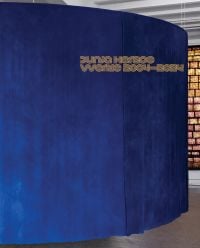
Dunja Herzog – Solothurn Art Museum, Switzerland
2 Jun — 6 Oct 2024
The first comprehensive institutional solo exhibition by Dunja Herzog (*1976 in Basel) at the Kunstmuseum Solothurn brings together new, newly staged and existing works from past years. Rarely starting with completed works, the artist often works on the further development of individual projects over a longer period of time.
Connected to the African continent since her childhood (her parents worked for two years in a hospital in Cameroon), she has lived in Nigeria, Cameroon or South Africa for several months each year since 2003. As a result, the exhibition interweaves themes, materials and techniques from different cultural, temporal and biographical contexts. The connecting element and common thread is the sound, which characterizes the individual rooms differently – from deep rumbling to silent bells, from jazzy melodies to room-filling pulsations.
Materials and craft techniques are of central importance as carriers of diverse stories. Sometimes they also act as triggers for chains of associations and new processes. For example, Herzog’s interest in bees developed from his experience with bronze casting in Benin, where wax is used. This in turn led to collaboration with beekeepers Thembalezwe Mntambo and Cosmas Ndlovu. They use clay from South Africa as a material to create species-appropriate bee habitats.* Transferred from the outside to the exhibition space, the objects, whose design fluctuates between craftsmanship and biomorphic experiment, raise questions about the distribution of resources and how we deal with them – as well as about the spheres of influence of art.
Algae, which are one of the most promising raw materials of the future as an important supplier of oxygen, have long played an important role in Herzog’s artistic practice. Assembled to form monumental curtains, the Sea Sheets (Logic of connectivity) , nori leaves allow sunlight to shine through and convey an underwater scenario. Metaphorically, the work refers to the term “underwater economy”, which was coined by the feminist sociologist and anti-capitalist Maria Mies. She points out that wage labor is only the “tip of the iceberg” of exploitation, which rests on a massive foundation of unpaid care and reproductive work, predominantly performed by women and people of color.
The connection between colonialism, trade flows and money flows is omnipresent in Dunja Herzog’s work: the monumental installation Blue Gold – Soft Spheres is a spatial sculpture consisting of two textile cylinders interlocking with each other. Created in indigo dye works – on the one hand with indigo-dyed cotton from Nigeria and on the other with woad on linen from Germany – the installation addresses the trade routes of the blue dye. After arriving in India, Vasco da Gama exported indigo to Europe and thereby gradually brought woad production in Europe to a standstill. In turn, the export of chemical blue dye by the Union Trading Company (UTC) had an impact on the old tradition of indigo dyeing in Nigeria.
On the occasion of the first Lagos Biennale in 2017, Herzog acquired original furniture and other objects from the company UTC Nigeria Ltd., which was in the process of being dissolved at the time. Here the artist creates a direct connection to her personal history: UTC, founded in 1921 and previously known as the Missions-Handels-Gesellschaft (under the management of the Basel Mission), sold, among other things, watches from the Basel-based company Oris in West Africa. Oris was formerly owned by the Herzog family. By staging a UTC foyer within the exhibition, Herzog explores past economic events and recontextualizes them.
Questions about personal responsibility are inscribed in the exhibition. Each installation can be read as a chapter of interwoven stories in which the artist is personally involved.
Special thanks to the Swisslos Fund of the Canton of Solothurn, the Däster-Schild Foundation, Department of Culture Basel-Stadt, the Hans and Renée Müller-Meylan Foundation and Videocompany, Zofingen. Many thanks also to the Museum of Cultures Basel for the loan.
Guest curator: Marianne Burki, art historian
Please log-in or create an account to see your recent items.